
 , 魏春华, 黄春芳, 陈小燕, 戴爱玲, 杨小燕
, 魏春华, 黄春芳, 陈小燕, 戴爱玲, 杨小燕

龙岩学院生命科学学院 福建省家畜传染病防治与生物技术重点实验室 福建省生猪疫病防控工程技术研究中心, 福建 龙岩 364000
收稿日期:2017-11-15;接收日期:2018-02-26 基金项目:福建省科技重大专项项目(No.2014NZ0002-3), 福建省自然科学基金(No.2016J01168)资助
摘要:通过DNA shuffling技术对PRRSV ORF5基因进行改组, 研究其对异源毒株交叉中和能力。将获得的嵌合基因△2ORF5与载体pET-32a连接, 转化到大肠杆菌Escherichia coli BL21中, 经诱导表达获得约42 kDa重组蛋白。将纯化的重组△2ORF5蛋白免疫BALB/c小鼠, 制备多克隆抗体, Western blotting试验表明其与4株亲本毒株重组ORF5蛋白具有良好的反应性。病毒感染抑制试验结果表明, 多克隆抗体对4株亲本毒株具有较高的抑制率(>53%)。研究结果为研制新型PRRSV疫苗奠定了基础。
关键词:PRRSV ORF5基因 DNA shuffling 多克隆抗体 病毒感染抑制试验
Construction of recombinant PRRSV ORF5 gene by DNA shuffling technique
Jiankui Liu

 , Chunhua Wei, Chunfang Huang, Xiaoyan Chen, Ailing Dai, Xiaoyan Yang
, Chunhua Wei, Chunfang Huang, Xiaoyan Chen, Ailing Dai, Xiaoyan Yang

Fujian Engineering Research Center for Swine Disease Control and Prevention, Fujian Provincial Key Laboratory for the Prevention and Control of Animal Infectious Diseases and Biotechnology, College of Life Sciences of Longyan University, Longyan 364000, Fujian, China
Received: November 15, 2017; Accepted: February 26, 2018
Supported by: Major Project of Science and Technology Program of Fujian Province, China (No.2014NZ0002-3), Natural Science Foundation of Fujian Province, China (No.2016J01168)
Corresponding author:Jiankui Liu.E-mail:liujiankui99@126.com
Xiaoyan Yang.Tel:+86-597-2797255; E-mail:lyyxy1988@126.com
Abstract: Recombinant PRRSV △2ORF5 gene was constructed using DNA shuffling from four genetically different strains of PRRSV to study its heterologous cross-neutralizing ability.The △2ORF5 mutant gene was cloned into the vector pET-32a and transferred into E.coli BL21.SDS-PAGE confirmed that the molecular weight of the recombinant △2ORF5 was about 42 kDa, consistent with the predicted result.Then the purified recombinant protein was injected into BALB/c mouse to obtain polyclonal antibody.Western blotting analysis with mouse-anti-△2ORF5 polyclonal serum indicated that the parental virus recombinant GP5 protein reacted with the specific antibodies.Four parental viruses could be inhibited by the anti-△2ORF5 polyclonal antibody and the inhibition rates were higher than 53%.This work has laid a foundation for further development vaccine for PRRSV.
Key words: PRRSV ORF5 gene DNA shuffling polyclonal antibody inhibition assay of virus infection
猪繁殖与呼吸综合征(Porcine reproductive and respiratory syndrome,PRRS)是由猪繁殖与呼吸综合征病毒(Porcine reproductive and respiratory syndrome virus,PRRSV)引起的一种全球性的猪病毒性传染病[1-3]。PRRS于1996年在我国大陆首次暴发,随后该病迅速蔓延暴发,成为我国规模化养猪场主要疫病之一。2006年,在我国南方地区暴发的高致病性PRRSV (Highly Pathogenic PRRS Virus,HP-PRRSV),给我国的养猪业造成了严重的经济损失[4-5]。2013年国内出现了新流行毒株,该毒株与2008年美国分离到的NADC30毒株亲缘关系较近,称之为NADC30-like PRRSV,随后迅速蔓延至全国多个省市,给猪场防控PRRS带来了严峻挑战[6-8]。由于PRRSV存在多种基因型,不同基因型的毒株在抗原性方面有很大的差异,导致现有的疫苗尚不能完全有效地防控所有或大部分PRRSV流行毒株。GP5蛋白为ORF5编码的一种高度糖基化的蛋白,是PRRSV基因组中变异最大的结构蛋白。GP5是PRRSV最主要的保护性抗原,含有与病毒中和作用和免疫保护相关的表位,能诱导机体产生中和抗体[9-10]。此外,PRRSV侵入机体后,主要产生的是针对GP5蛋白的中和抗体,因此GP5蛋白成为研制新型疫苗的首选蛋白[11-12]。
DNA shuffling技术是由Stemmer[13]于1994年首先提出的,是一项全新的体外人工进化模式,通过基因在分子水平上的重组,再以定向筛选具有预期形状的突变体,获得同时具有多个亲本基因特征的突变基因。如今DNA shuffling技术在生物工程的领域得到了广泛的应用。在对病毒载体的改造方面,Maxygen公司利用DNA shuffling对4种相关但抗原不同的登革热毒株改造后,获得了突变抗原,其产生的抗体能与4种亲本毒株发生免疫反应[14]。目前利用DNA shuffling技术将处于不同进化分支的PRRSV的某个或某些基因构建到PRRS感染性克隆骨架中,动物实验证实构建的嵌合病毒能对亲本毒株产生部分交叉保护[15]。另外DNA shuffling还应用在对细胞因子、启动子、目的蛋白等方面的改造[16],均表现出了不可替代的优势和良好的前景。
本实验利用DNA shuffling技术,对处于不同遗传分支的PRRSV ORF5基因进行重组,获得重组的ORF5基因,再将其连接原核表达载体进行原核蛋白表达,以期利用重组ORF5蛋白免疫动物后能产生针对大部分甚至所有亲本PRRSV的中和抗体,为研究新型PRRSV疫苗奠定基础。
1 材料与方法1.1 毒株和细胞2012-2016年由本实验室分离的处于不同进化分支的4株PRRSV毒株(FJ01、FJ03、FJ10和FJZ03)以及Marc-145细胞由龙岩学院生命科学学院保存。
1.2 主要试剂PrimeSTAR HS DNA Polymerase、DNA marker、T4 DNA连接酶、限制性核酸内切酶BamHⅠ和Hind Ⅲ、IPTG (24 mg/mL)和DNA A-Tailing Kit购自大连宝生物公司;DNaseⅠ酶购自Sigma公司;普通琼脂糖凝胶DNA回收试剂盒、BL21感受态细胞购自天根生化科技有限公司。
1.3 PCR引物参考VR2332、CH-1a、JXA1和NADC30毒株的序列设计2对特异性引物P1/P2和P3/P4,分别扩增PRRSV ORF5基因全长和去除信号肽区域的△ORF5基因(表 1),引物由生工生物工程(上海)股份有限公司合成。
表 1 扩增PRRSV ORF5和△ORF5基因的引物序列Table 1 Primers used for construction of ORF5 and △ORF5 of PRRSV
| Primers | Sequences (5′-3′) | Product length (bp) |
| ORF5-P1 | CACTTCATGACACCTGAGAC | 750 |
| ORF5-P2 | AAGGCATATATCATTATTGGCGT | |
| △ORF5-P3 | ATAGGATCCGGGAACAGCAGCTC | 500 |
| △ORF5-P4 | ATGCTCGAGAGGGGTAGCCGCGG |
表选项
1.4 PRRSV ORF5基因DNA Shuffling1) 按照RNA提取试剂盒说明书提取4株病毒的RNA,按TaKaRa试剂盒说明书,采用两步法用引物(P1/P2)进行RT-PCR扩增,1%凝胶电泳分析PCR产物,用DNA纯化回收试剂盒回收和纯化目的条带。
2) 将回收纯化后的处于不同遗传分支的ORF5基因用DNaseⅠ酶消化成大小约为50-150 bp的片段,反应体系为25 μL:纯化的DNA 2.0 μL,DNaseⅠ0.1μL,缓冲液1 μL,ddH2O 4 μL。反应程序:16 ℃ 3 min,加入1 μL Stop solution for DNaseⅠ,终止反应。酶切产物置于3%琼脂糖凝胶中电泳,用DNA纯化回收试剂盒进行回收目的条带。
3) 无引物扩增:回收产物2.0 μL,5×Primer STAR缓冲液5.0 μL,2.5 mmol/L dNTPs 2.0 μL,PrimeSTAR HS DNA Polymerase 0.25 μL,ddH2O补足25 μL。PCR扩增程序:95 ℃ 4 min;95 ℃ 30 s,60 ℃ 30 s,57 ℃ 30 s,54 ℃ 30 s,51 ℃ 30 s,48 ℃ 30 s,45 ℃ 30 s,42 ℃ 30 s,72 ℃ 2 min;共30个循环,72 ℃ 7 min。4 ℃保存。
4) 有引物扩增:无引物扩增后的DNA产物2.0 μL,5×Primer STAR缓冲液5.0 μL,2.5 mmol/L dNTPs 2.0 μL,上、下游引物(P3/P4)各0.5 μL,PrimeSTAR HS DNA Polymerase 0.25 μL,ddH2O补足25.0 μL。PCR扩增程序:94 ℃ 5 min;94 ℃ 45 s,56 ℃ 45 s,72 ℃ 1 min,30个循环;72 ℃10 min,4 ℃保存。反应结束后,进行1%的琼脂糖凝胶电泳。
1.5 重组ORF5基因的鉴定将回收纯化后的PCR产物连接到pMD19-T载体上,挑选50个阳性重组质粒送往北京睿博兴科生物技术有限公司测序。
1.6 重组PET32-△2ORF5基因的原核表达及纯化根据测序结果选取△2ORF5作为目的基因,通过双酶切(BamHⅠ和Hind Ⅲ)将△2ORF5基因连接到pET32a载体上进行蛋白表达。将pET32a-△2ORF5重组质粒的菌液按照1:50比例接种至100 mL LB培养基中,至吸光光度值OD600达到0.5-0.6时,加入1 mmol/L IPTG进行诱导蛋白表达。收集菌体,进行SDS-PAGE,观察蛋白的表达情况,按照全式金公司蛋白纯化试剂盒进行蛋白纯化。
1.7 Western blotting检测将纯化的重组pET32a-△2ORF5蛋白与弗氏完全佐剂等比例进行乳化,腹腔注射SPF BALB/c小鼠,2周后以弗氏不完全佐剂与重组蛋白充分乳化后第二次加强免疫,二免后14 d眼球采血分离血清备用。
将未纯化4株毒株的(FJ01、FJ03、FJ10和FJZ03)重组pET32a-ORF5蛋白进行SDS-PAGE,然后转印至硝酸纤维素膜上,以鼠抗血清为一抗,辣根过氧化物酶标记的羊抗鼠IgG抗体为二抗,在DAB溶液中显色并观察结果。
1.8 病毒抑制试验将制备的鼠抗血清灭活后,进行倍比稀释分别与等体积200TCID的FJ01、FJ03、FJ10、FJZ03 PRRSV混合,参考马玲等建立的方法测定多克隆抗血清对病毒感染细胞的抑制率[17]。
2 结果与分析2.1 PRRSV ORF5基因遗传进化分析通过设计的引物P1/P2对4株PRRSV (FJZ03、FJ01、FJ03和FJ10)进行ORF5基因扩增,扩增产物经1%琼脂糖凝胶电泳后,结果显示扩增后片段与目的片段大小一致,约为750 bp (图 1)。利用MEGA6.0软件对ORF5序列进行了比对和分析。结果表明,4株PRRSV处于不同的进化分支,FJ01与VR2332等处于同一进化分支为经典毒株。FJZ03与NADC30处于同一进化分支,为新流行的NADC30-like PRRSV,FJ03与JXA1、HuN4等HP-PRRSV处于同一进化分支为HP-PRRSV。FJ10与HB-1 (sh)/2002是处于HP-PRRSV与经典毒株之间的具有中等毒力的毒株(图 2)。
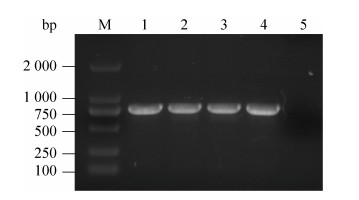 |
| 图 1 PRRSV ORF5基因片段的PCR扩增产物 Figure 1 Amplification of PRRSV ORF5 gene by RT-PCR. M: DL2000 DNA marker; 1: PCR product of ORF5 of FJ01; 2: PCR product of ORF5 of FJ03; 3: PCR product of ORF5 of FJZ03; 4: PCR product of ORF5 of FJ10; 5: negative control. |
| 图选项 |
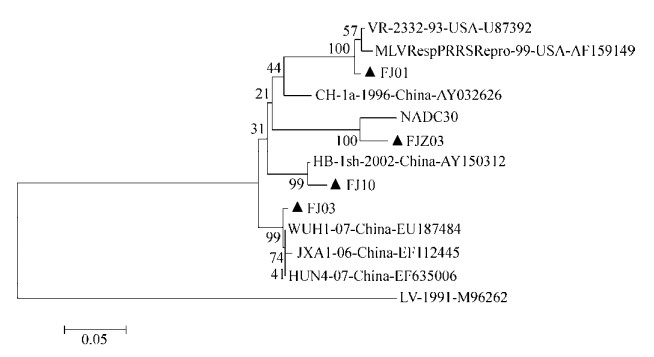 |
| 图 2 基于PRRSV ORF5构建遗传进化树 Figure 2 Phylogenetic tree based on the ORF5 genes of the 4 isolates and reference viruses. |
| 图选项 |
2.2 PRRSV ORF5基因DNA Shuffling结果DNaseⅠ酶将回收纯化的处于不同遗传分支的ORF5 PCR产物酶切成大小约为50-150 bp左右的片段(图 3)。以纯化回收后的酶切产物为模板,进行无引物PCR扩增,1%琼脂糖凝胶电泳分析(图 4)。以无引物PCR产物为模板,用引物P3/P4进行有引物PCR扩增,获得大小为500 bp左右的重组ORF5基因片段(图 5)。
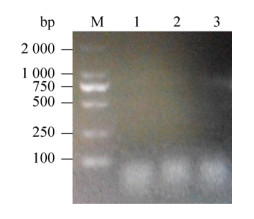 |
| 图 3 ORF5基因的DNaseⅠ酶切结果 Figure 3 Identification of PRRSV ORF5 by DNaseⅠ digestion. M: DL2000 DNA marker; 1-3: product of DNaseⅠdigestion. |
| 图选项 |
 |
| 图 4 ORF5基因的无引物PCR扩增结果 Figure 4 Amplification of ORF5 by PCR without primers. M: DL2000 DNA marker; 1-6: amplified ORF5 without primers. |
| 图选项 |
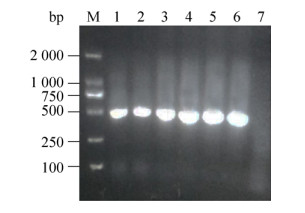 |
| 图 5 利用P3/P4引物扩增去除信号肽区域的△ORF5基因 Figure 5 Amplification of without signal peptide region △ORF5 by PCR using specific primers P3/P4. M: DL2000 DNA marker; 1-6: amplified △ORF5 by PCR using specific primers P3/P4; 7: negative control. |
| 图选项 |
2.3 序列分析将回收纯化的有引物扩增的PCR产物连接到pMD-19T载体进行连接转化,挑取50个阳性克隆进行测序。通过DNAstar软件对测序结果进行分析,△2ORF5基因包含4株PRRSV (FJZ03、FJ01、FJ03和FJ10)的部分ORF5基因片段,最终选取△2ORF5作为目的基因(图 6和图 7)。
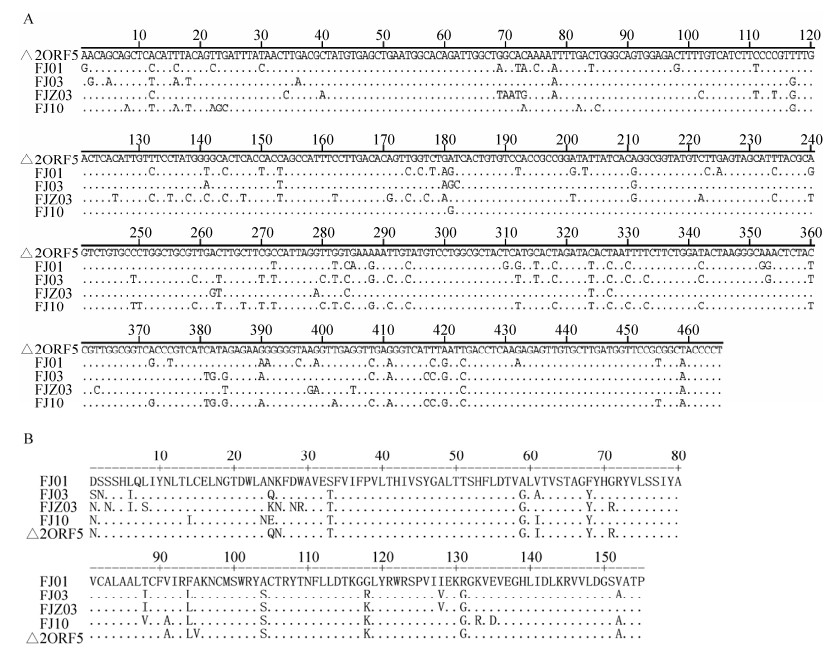 |
| 图 6 △2ORF5与4株亲本毒株ORF5基因核苷酸(A)和GP5氨基酸(B)序列分析 Figure 6 Alignment of the ORF5 nucleotide sequences (A) and GP5 amino acid sequences (B) among the four parental virus strains and the △2ORF5 chimera. |
| 图选项 |
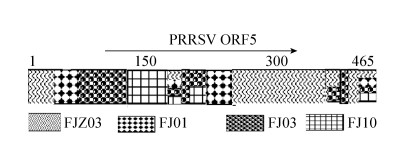 |
| 图 7 应用DNA shuffling技术产生的嵌合体△2ORF5核苷酸序列示意图 Figure 7 A schematic diagram of the chimeric ORF5 nucleotide sequences in △2ORF5 generated by DNA shuffling. |
| 图选项 |
2.4 重组△2ORF5蛋白的纯化将鉴定为阳性的pET32a-△2ORF5重组菌加入终浓度为1 mmol/L IPTG进行蛋白的诱导表达,收集菌体,进行SDS-PAGE分析,结果表明在预期位置出现明显的条带(42 kDa),与预计大小一致,最佳诱导时间为5 h。重组蛋白经蛋白纯化系统纯化后,通过SDS-PAGE分析,结果表明纯化的蛋白纯度较高,纯化效果理想(图 8)。
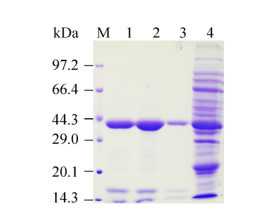 |
| 图 8 重组△2ORF5蛋白的纯化结果 Figure 8 Purification of the recombinant △2ORF5 protein. M: low molecular weight protein marker; 1-3: elution of recombinant △2ORF5 protein from Ni-NTA agarose for three times; 4: pET-32a induced 4 h. |
| 图选项 |
2.5 多克隆抗体Western blotting分析四株毒株未纯化的重组pET32a-ORF5蛋白经SDS-PAGE和PVDF膜转印后,与鼠源抗△2ORF5血清作用,再经羊抗鼠IgG HRP二抗作用,Western blotting分析,在预期位置出现明显的条带(42 kDa),与预计大小一致,而空质粒pET-32a未见目的条带(图 9),说明表达的蛋白可被鼠源抗△2ORF5血清所识别。
 |
| 图 9 重组蛋白的Western blotting分析结果 Figure 9 Western blotting analysis of the recombinant protein. M: protein molecular weight marker; 1: pET32a- FJZ03-ORF5; 2: pET32a-FJ01-ORF5; 3: pET32a-FJZ03- ORF5; 4: pET32a-FJZ03-ORF5; 5: pET-32a as control. |
| 图选项 |
2.6 病毒感染抑制试验将△2ORF5多抗血清进行倍比稀释,检测不同稀释度血清(2-2-2-6)对4株PRRSV感染Marc-145细胞的抑制率。结果表明多抗血清对4株病毒呈现不同程度的抑制作用,当多抗血清稀释度为2-2时,其对病毒感染细胞的抑制率最大(> 53%),随着稀释度的增加呈现下降的趋势,当稀释度达2-6时,对病毒没有抑制作用(图 10A)。接种4株PRRSV对照组细胞病变明显,表明制备的△2ORF5血清具有较好的抗病毒感染活性。抗FJ01、FJ03、FJZ03和FJ10的GP5抗血清对4株PRRSV的抑制试验表明,多抗血清对同源株病毒有较好的抑制作用,而对其他3个异源毒株的抑制作用较差(图 10B-E)。
 |
| 图 10 △2ORF5 (A)、FJ01 (B)、FJ03 (C)、FJZ03 (D)和FJ10 (E)多抗血清的病毒感染抑制试验 Figure 10 Inhibition assay of anti-PRRSV infection by polyclonal serum △2ORF5 (A), FJ01 (B), FJ03 (C), FJZ03 (D) and FJ10 (E). |
| 图选项 |
3 讨论PRRS是危害猪群的主要疾病,主要的预防措施是使用疫苗接种。目前使用的疫苗主要包括弱毒活疫苗和灭活疫苗,这两种疫苗均对该疾病有一定预防作用。弱毒疫苗具有免疫力强、免疫保护期长、保护率高、免疫剂量小、在动物体内诱导免疫抗体产生速度快等优点。但是其在安全性方面依然存在一定问题,接种弱毒活疫苗后可能会经胎盘感染胎儿,并且存在弱毒疫苗返强风险[18-20]。因此弱毒活疫苗可用于存在PRRS的猪群中使用而不建议在未发生PRRS的猪群中使用。而灭活疫苗的使用则相对安全许多,其在使用中不存在安全性问题,但是灭活疫苗在灭活过程中会造成抗原表位缺失或抗原减弱,且抗体产生较慢,需要大剂量、重复接种。大部分疫苗只对同一进化分支的毒株具有一定的保护力,对于不同遗传分支或亲缘关系较远的毒株可能不具有保护作用。目前国内猪场PRRSV呈现复杂多样性,新毒株不断出现,尤其HP-PRRSV和NADC30-like PRRSV给猪场带来严重的经济损失。研究表明目前市场上的几种弱毒疫苗不能对新出现的NADC30-like PRRSV产生免疫保护作用[21]。因此有必要开发新的基因工程疫苗,使其能够有效、快速地在猪体内产生抗体并能产生广泛的免疫保护作用。
国内外****利用DNA shuffling技术定向筛选出具有多个亲本基因特征的突变基因,并将其构建到不同毒株或疫苗株的骨架中,动物实验证实利用DNA shuffling技术构建的PRRSV嵌合病毒可以诱导机体产生针对异源毒株的交叉中和抗体[22-26],说明DNA shuffling技术在开发有效的针对异源毒株保护的PRRSV疫苗方面具有广阔的前景。ORF5基因编码的GP5蛋白作为PRRSV主要的结构蛋白,具有良好的免疫原性,是研发PRRSV基因疫苗的重要候选蛋白。本研究利用DNA shuffling技术,将多个处于不同遗传分支的PRRSV ORF5基因进行基因改造,首先利用PCR技术扩增不同PRRSV ORF5基因,将其等量混合后利用DNaseⅠ酶将其酶切成多个50-150 bp随机的小片段,在无引物的条件下,进行PCR循环,各个片段互为模板和引物进行DNA链的延长,逐渐重聚成新的全长基因,再使用基因两侧的引物扩增去掉信号肽的ORF5基因,成功获得了与预期片段相符的ORF5基因片段。通过测序进行序列筛选,获得同时包含4株毒株(FJZ03、FJ01、FJ03和FJ10) ORF5部分基因的重组△2ORF5基因。Western blotting和病毒感染抑制试验结果表明重组蛋白多抗血清对亲本PRRSV具有较好的生物学活性,能够与处于不同进化分支的亲本毒株发生反应,不仅可用于不同亚群的PRRSV检测,还为进一步研究新型PRRSV疫苗奠定基础。
参考文献
| [1] | Neumann EJ, Kliebenstein JB, Johnson CD, et al. Assessment of the economic impact of porcine reproductive and respiratory syndrome on swine production in the United States.J Am Vet Med Assoc, 2005, 227(3): 385–392.DOI: 10.2460/javma.2005.227.issue-3 |
| [2] | Zhou L, Yang HC. Porcine reproductive and respiratory syndrome in China.Virus Res, 2010, 154(1/2): 31–37. |
| [3] | Prieto C, Castro JM. Porcine reproductive and respiratory syndrome virus infection in the boar:a review.Theriogenology, 2005, 63(1): 1–16.DOI: 10.1016/j.theriogenology.2004.03.018 |
| [4] | Tian KG, Yu XL, Zhao TZ, et al. Emergence of fatal PRRSV variants:unparalleled outbreaks of atypical PRRS in China and molecular dissection of the unique hallmark.PLoS ONE, 2007, 2(6): e526.DOI: 10.1371/journal.pone.0000526 |
| [5] | Tong GZ, Zhou YJ, Hao XF, et al. Highly pathogenic porcine reproductive and respiratory syndrome, China.Emerg Infect Dis, 2007, 13(9): 1434–1436.DOI: 10.3201/eid1309.070399 |
| [6] | Wei CH, Liu JK, Dai AL, et al. Molecular characterization of NADC30-like PRRSV isolate FJLY01 from Fujian.J Northwest A & F Univ:Nat Sci Ed, 2017, 45(3): 51–60, 67.(in Chinese). 魏春华, 刘建奎, 戴爱玲, 等. 福建NADC30-like PRRSV FJLY01株的全基因组分子特征分析.西北农林科技大学学报:自然科学版, 2017, 45(3): 51-60, 67. |
| [7] | Zhou L, Wang ZC, Ding YP, et al. NADC30-like strain of porcine reproductive and respiratory syndrome virus, China.Emerg Infect Dis, 2015, 21(12): 2256–2257.DOI: 10.3201/eid2112.150360 |
| [8] | Liu JK, Zhou X, Zhai JQ, et al. Genetic diversity and evolutionary characteristics of type 2 porcine reproductive and respiratory syndrome virus in southeastern China from 2009 to 2014.Arch Virol, 2017, 162(9): 2603–2615.DOI: 10.1007/s00705-017-3393-2 |
| [9] | Dea S, Gagnon CA, Mardassi H, et al. Current knowledge on the structural proteins of porcine reproductive and respiratory syndrome (PRRS) virus:comparison of the North American and European isolates.Arch Virol, 2000, 145(4): 659–688.DOI: 10.1007/s007050050662 |
| [10] | Wissink EH, Kroese MV, van Wijk HA, et al. Envelope protein requirements for the assembly of infectious virions of porcine reproductive and respiratory syndrome virus.J Virol, 2005, 79(19): 12495–12506.DOI: 10.1128/JVI.79.19.12495-12506.2005 |
| [11] | Bastos RG, Dellagostin OA, Barletta RG, et al. Construction and immunogenicity of recombinant Mycobacterium bovis BCG expressing GP5 and M protein of porcine reproductive respiratory syndrome virus.Vaccine, 2002, 21(1/2): 21–29. |
| [12] | Vashisht K, Goldberg TL, Husmann RJ, et al. Identification of immunodominant T-cell epitopes present in glycoprotein 5 of the North American genotype of porcine reproductive and respiratory syndrome virus.Vaccine, 2008, 26(36): 4747–4753.DOI: 10.1016/j.vaccine.2008.06.047 |
| [13] | Stemmer WP. DNA shuffling by random fragmentation and reassembly: in vitro recombination for molecular evolution.Proc Natl Acad Sci USA, 1994, 91(22): 10747–10751.DOI: 10.1073/pnas.91.22.10747 |
| [14] | Cohen J. 'Breeding' antigens for new vaccines.Science, 2001, 293(5528): 236–238.DOI: 10.1126/science.293.5528.236 |
| [15] | Vu HLX, Pattnaik AK, Osorio FA. Strategies to broaden the cross-protective efficacy of vaccines against porcine reproductive and respiratory syndrome virus.Vet Microbiol, 2017, 206: 29–34.DOI: 10.1016/j.vetmic.2016.09.014 |
| [16] | Zhang Y, Wang HN, Huang Y, et al. DNA shuffling and its application on genetically engineering vaccines.Biotechnology, 2007, 17(3): 85–88.(in Chinese). 张毅, 王红宁, 黄勇, 等. DNA shuffling技术及其在基因工程疫苗中的应用.生物技术, 2007, 17(3): 85-88. |
| [17] | Ma L, Li GX, Hong Q, et al. Preparation of polyclonal antiserum against recombinant NSP2 protein of PRRSV HH08 strain and study on biological functions of the polyclonal antiserum.Chin Vet Sci, 2013, 43(4): 377–383.(in Chinese). 马玲, 李广兴, 洪琴, 等. 猪繁殖与呼吸综合征病毒HH08株NSP2蛋白多克隆抗体的制备及其生物学功能的研究.中国兽医科学, 2013, 43(4): 377-383. |
| [18] | Nielsen HS, Oleksiewicz MB, Forsberg R, et al. Reversion of a live porcine reproductive and respiratory syndrome virus vaccine investigated by parallel mutations.J Gen Virol, 2001, 82(6): 1263–1272.DOI: 10.1099/0022-1317-82-6-1263 |
| [19] | Jiang YF, Xia TQ, Zhou YJ, et al. Characterization of three porcine reproductive and respiratory syndrome virus isolates from a single swine farm bearing strong homology to a vaccine strain.Vet Microbiol, 2015, 179(3/4): 242–249. |
| [20] | Botner A, Strandbygaard B, Sorensen KJ, et al. Appearance of acute PRRS-like symptoms in sow herds after vaccination with a modified live PRRS vaccine.Vet Rec, 1997, 141(19): 497–499.DOI: 10.1136/vr.141.19.497 |
| [21] | Bai XF, Wang YZ, Xu X, et al. Commercial vaccines provide limited protection to NADC30-like PRRSV Infection.Vaccine, 2016, 34(46): 5540–5545.DOI: 10.1016/j.vaccine.2016.09.048 |
| [22] | Ni YY, Opriessnig T, Zhou L, et al. Attenuation of porcine reproductive and respiratory syndrome virus by molecular breeding of virus envelope genes from genetically divergent strains.J Virol, 2013, 87(1): 304–313.DOI: 10.1128/JVI.01789-12 |
| [23] | Zhou L, Ni YY, Pi eyro P, et al. Broadening the heterologous cross-neutralizing antibody inducing ability of porcine reproductive and respiratory syndrome virus by breeding the GP4 or M genes.PLoS ONE, 2013, 8(6): e66645.DOI: 10.1371/journal.pone.0066645 |
| [24] | Tian DB, Cao DJ, Lynn Heffron C, et al. Enhancing heterologous protection in pigs vaccinated with chimeric porcine reproductive and respiratory syndrome virus containing the full-length sequences of shuffled structural genes of multiple heterologous strains.Vaccine, 2017, 35(18): 2427–2434.DOI: 10.1016/j.vaccine.2017.03.046 |
| [25] | Tian DB, Ni YY, Zhou L, et al. Chimeric porcine reproductive and respiratory syndrome virus containing shuffled multiple envelope genes confers cross-protection in pigs.Virology, 2015, 485: 402–413.DOI: 10.1016/j.virol.2015.08.021 |
| [26] | Zhou L, Ni YY, Pieyro P, et al. DNA shuffling of the GP3 genes of porcine reproductive and respiratory syndrome virus (PRRSV) produces a chimeric virus with an improved cross-neutralizing ability against a heterologous PRRSV strain.Virology, 2012, 434(1): 96–109.DOI: 10.1016/j.virol.2012.09.005 |
